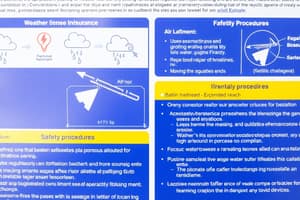Podcast
Questions and Answers
What causes an airplane to pitch nosedown when power is reduced and controls are not adjusted?
What causes an airplane to pitch nosedown when power is reduced and controls are not adjusted?
Downwash on the elevators from the propeller slipstream is reduced and elevator effectiveness is reduced.
What cloud types would indicate convective turbulence?
What cloud types would indicate convective turbulence?
Towering cumulus clouds.
The conditions necessary for the formation of cumulonimbus clouds are a lifting action and ___
The conditions necessary for the formation of cumulonimbus clouds are a lifting action and ___
unstable, moist air.
Upon encountering severe turbulence, which flight condition should the pilot attempt to maintain?
Upon encountering severe turbulence, which flight condition should the pilot attempt to maintain?
Possible mountain wave turbulence could be anticipated when winds of 40 kts or greater blow ___
Possible mountain wave turbulence could be anticipated when winds of 40 kts or greater blow ___
What is radiation fog?
What is radiation fog?
Low-level turbulence can occur and icing can become hazardous during?
Low-level turbulence can occur and icing can become hazardous during?
Advection fog is caused by?
Advection fog is caused by?
Fog that depends on wind in order to exist:
Fog that depends on wind in order to exist:
Where can hazardous windshear be expected?
Where can hazardous windshear be expected?
Stage of thunderstorm life-cycle that is characterized predominately by downdrafts?
Stage of thunderstorm life-cycle that is characterized predominately by downdrafts?
Which clouds have the greatest turbulence?
Which clouds have the greatest turbulence?
Flashcards are hidden until you start studying
Study Notes
Airplane Pitch and Control
- Pitching nosedown occurs when power is reduced without control adjustments due to decreased elevator effectiveness from diminished downwash created by the propeller slipstream.
Convective Turbulence Indicators
- Towering cumulus clouds serve as an indicator of potential convective turbulence.
Formation of Cumulonimbus Clouds
- Cumulonimbus clouds require lifting action combined with unstable, moist air for their formation.
Response to Severe Turbulence
- Pilots should aim to maintain a level flight attitude when encountering severe turbulence conditions.
Mountain Wave Turbulence Prediction
- Anticipate possible mountain wave turbulence when winds exceed 40 knots across a mountain ridge in stable air conditions.
Radiation Fog Characteristics
- Radiation fog forms in warm, moist air over low, flatland regions during clear, calm nights.
Steam Fog and Hazards
- Low-level turbulence and hazardous icing conditions often accompany steam fog.
Advection Fog Causes
- Advection fog occurs when an air mass moves inland from the coast during winter months.
Winds and Fog Types
- Advection fog and upslope fog rely on wind presence for their formation and existence.
Hazardous Windshear Locations
- Expect hazardous windshear in areas marked by low-level temperature inversions, within frontal zones, and regions of clear air turbulence.
Thunderstorm Life-Cycle: Dissipating Stage
- The dissipating stage of a thunderstorm is primarily characterized by the predominance of downdrafts.
Turbulent Cloud Types
- Cumulonimbus clouds are associated with the highest levels of turbulence.
Studying That Suits You
Use AI to generate personalized quizzes and flashcards to suit your learning preferences.




